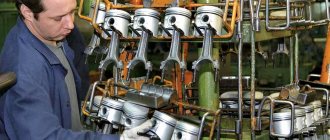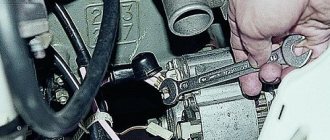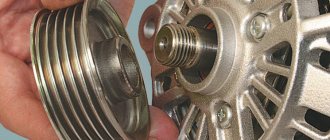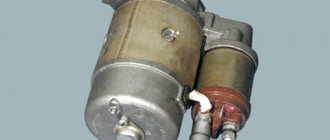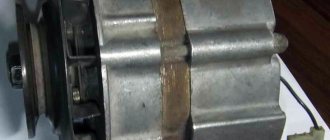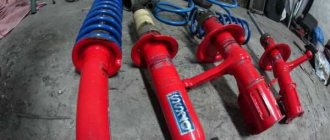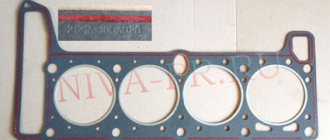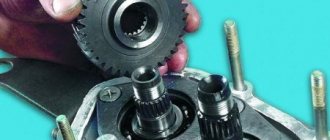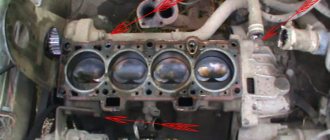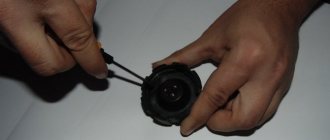Payment for goods and downloading of the book in electronic form (PDF format) is made on the website.
To do this, you need to find the book you are interested in and click on the “Buy” button. The price of the book is indicated on the button.
For convenience, the price on the website for residents of Russia, Belarus and Kazakhstan is presented in rubles.
For residents of Ukraine in hryvnias, and for all other countries - dollars.
After clicking on the “BUY” button, a payment window will open where you can select a payment system with which you can pay for the selected book using any bank card (Visa, MasterCard, MIR, etc.)
When you click on the “Pay by bank card” button, the Portmone payment system will open, which is the easiest way to make a payment.
In addition, the website offers four payment systems for payment:
- Yandex (payment from any bank cards, Yandex Money account, QIWI Wallet, terminals, etc.);
- Portmone (payment from any bank cards, Portmone account);
- PayPal (payment from any bank cards, PayPal account);
- WebMoney (payment from any bank cards, payment from WebMoney wallets).
Payment via Yandex Cashier
After selecting payment via Yandex, the Yandex Cashier payment system will launch, where you need to select a convenient payment method (bank card, QIWI, Yandex Money account, etc.)
After specifying payment details and confirming payment, payment for the goods will occur.
If you have a bank card in a currency other than the ruble, then the money will be debited from the card at the rate of the Central Bank of Russia at the time of the purchase.
This payment method is optimal for residents of Russia, Kazakhstan and Belarus.
Official website of the Yandex Kassa payment system https://kassa.yandex.ru
Selecting the site language
Afrikaans Albanian Amharic Arabic Armenian Azerbaijani Basque Belarusian Bengali Bosnian Bulgarian Catalan Cebuano Chichewa Chinese (Simplified) Chinese (Traditional) Corsican Croatian Czech Danish Dutch English Esperanto Estonian Filipino Finnish French Frisian Galician Georgian German Greek Gujarati Haitian Creole Hausa Hawaiian Hebrew Hindi Hmong Hungarian Icelandic Igbo Indonesian Irish Italian Japanese Javanese Kannada Kazakh Khmer Korean Kurdish (Kurmanji) Kyrgyz Lao Latin Latvian Lithuanian Luxembourgish Macedonian Malagasy Malay Malayalam Maltese Maori Marathi Mongolian Myanmar (Burmese) Nepali Norwegian Pashto Persian Polish Portuguese Punjabi Romanian Russian Samoan Scottish Gaelic Serbian Sesotho Shona Sindhi Sinhala Slovak Slovenian Somali Spanish Sudanese Swahili Swedish Tajik Tamil Thai Turkish Ukrainian Urdu Uzbek Vietnamese Welsh Xhosa Yiddish
Payment via Portmone
After selecting payment through Portmone, the payment system will launch, where you need to select the payment method: bank card or Portmone account.
The price in the Portmone payment system is converted into dollars at the exchange rate of the Central Bank of the country where you are located.
If you have a bank card in a currency other than the dollar, then the money will be debited from the card at the rate of the Central Bank of your country at the time of the purchase.
After specifying payment details and confirming payment, payment for the goods will occur.
Official website of the Portmone payment system https://www.portmone.com
Reasons for removing the crankshaft
As a rule, it is necessary to dismantle the crankshaft pulley of a VAZ 2114 in three main cases:
- When replacing shaft seals (you can tell that it’s time to change them by oil leaks at their locations).
- For a number of repairs related to the gas distribution mechanism (for example, when replacing a belt).
- When replacing the pulley itself (however, it is quite rare to remove it for this very reason, because serious wear of the pulley is an infrequent occurrence).
But, be that as it may, it’s quite difficult to remove the pulley correctly for the first time without breaking or losing anything. This is caused by a number of inconveniences, for example, the hard-to-reach location of this part, which causes significant difficulty in unscrewing the fasteners (a long socket wrench or a socket with a large extension is most suitable for this operation).
Crankshaft bolt VAZ 2114
In addition, the pulley threads are tightened at the factory using mechanical impact wrenches with the maximum permissible force in order to prevent spontaneous unwinding. For obvious reasons, it is unlikely that such fasteners can be easily unscrewed “by hand” (in addition, the right-hand thread during engine operation works in the direction of tightening, further aggravating this situation).
When starting to dismantle the crankshaft pulley, be sure to stock up on WD-40 or kerosene - without them, this operation may end in failure.
Payment via PayPal
After selecting payment via PayPal, the PayPal payment system will launch, where you need to select the payment method: bank card or PayPal account.
If you already have a PayPal account, then you need to log into it and make a payment.
If you do not have a PayPal account and you want to pay using a bank card via PayPal, you need to click on the “Create an Account” button - shown with an arrow in the picture.
PayPal will then prompt you to select your country and provide your credit card information.
After specifying the information required to make the payment, you must click on the “Pay Now” button.
Official website of the PayPal payment system https://www.paypal.com
Reasons for removing the crankshaft
As a rule, it is necessary to dismantle the crankshaft pulley of a VAZ 2114 in three main cases:
- When replacing shaft seals (you can tell that it’s time to change them by oil leaks at their locations).
- For a number of repairs related to the gas distribution mechanism (for example, when replacing a belt).
- When replacing the pulley itself (however, it is quite rare to remove it for this very reason, because serious wear of the pulley is an infrequent occurrence).
But, be that as it may, it’s quite difficult to remove the pulley correctly for the first time without breaking or losing anything. This is caused by a number of inconveniences, for example, the hard-to-reach location of this part, which causes significant difficulty in unscrewing the fasteners (a long socket wrench or a socket with a large extension is most suitable for this operation).
Crankshaft bolt VAZ 2114
In addition, the pulley threads are tightened at the factory using mechanical impact wrenches with the maximum permissible force in order to prevent spontaneous unwinding. For obvious reasons, it is unlikely that such fasteners can be easily unscrewed “by hand” (in addition, the right-hand thread during engine operation works in the direction of tightening, further aggravating this situation).
When starting to dismantle the crankshaft pulley, be sure to stock up on WD-40 or kerosene - without them, this operation may end in failure.
Payment via WebMoney
After selecting payment via WebMoney, the payment system will launch, where you need to select the payment method: bank card or WebMoney wallet.
If you already have a WebMoney wallet, then you need to log into it and make a payment.
If you do not have a WebMoney wallet and you want to pay in another way, you need to select any of the methods that WebMoney offers and make the payment
After specifying payment details and confirming payment, payment for the goods will occur.
Official website of the WebMoney payment system https://www.webmoney.ru/
Determining motor faults
The compact, small-sized engine in the front-wheel drive VAZ 2108 is located transversely in the engine compartment. The gearbox is also located here, which simplifies access to repairing the main components of the car. Criteria by which motor malfunctions are determined:
- The engine does not want to start.
- It works unstably and may stall at idle.
- No full power during operation.
- A knocking sound is heard from the bearings located on the crankshaft.
- When the throttle valves are opened sharply, a knocking sound of the connecting rod bearings is heard when the engine is idling.
- The appearance of “beating” of the piston in the cylinder, which is accompanied by a muffled knock of the piston.
- Exhaust and intake valves are knocking.
- When idling, the oil pressure is insufficient.
- High oil consumption.
- Increased fuel consumption.
- The engine gets very hot.
- The coolant level in the expansion tank drops quickly.
If there is any malfunction, the VAZ 2108 engine requires repair - periodic or major.
Periodic engine repair
Constant maintenance of the engine consists of maintaining all its components and parts in good condition. This will postpone major engine repairs for the VAZ 21083, which means it will reduce the cost of operating the vehicle. These include:
- Timely replacement of filters.
- Change of oil.
- Checking the pressure in the cylinders will give an idea of the condition of the piston system
- Make sure the coolant is at the correct level.
Downloading a book
After successfully completing the payment (by any method) and returning to the KrutilVertel store from the payment system website, you will be taken to the successful payment page:
On this page you need to indicate your e-mail, where access to download the book will be sent.
If you are already registered on our website, then simply follow the link to your personal account.
The book you purchased will be in your personal account, from where you can always download it.
Please note that after making the payment, you need to return back from the payment system website to the KrutilVertel website.
If for some reason you did not return back to the site and closed the payment system tab with a message about the successful completion of the payment, please let us know - we will send you a letter indicating access to download the book.
Functionality check
Don't rush to conclusions. You shouldn’t blame DPKV for all the troubles. Sometimes it turns out that the cause of the problem is completely different. Therefore, first you should check whether your DC is working or not.
There are several ways to check.
- Multimeter. Your task is to measure the coil resistance on the induction sensor. If it is working properly, then the indicator will be from 500 to 700 Ohms.
Multifunctional multimeter
- Set the measurement limit on the multimeter to 200 millivolts, connect the probes to the output and pass a metal object around the core several times. If the sensor is working, it will be able to detect this metal and a voltage spike will appear on the display. If there are no surges, the DC must be replaced.
- An oscilloscope. This verification method gives the most objective and accurate result, equal to almost 100%. Connect the device to the engine and read data in different modes. The engine will need to be started at different speeds - from 800 and above, up to 6 thousand. Look at the lines appearing on the screen. If they are of different lengths, you should look for the reason for the malfunction. Sometimes simple cleaning of dirt, checking the pulley for damage and other measures helps.
Problems when paying with bank cards
Sometimes difficulties may arise when paying with Visa/MasterCard bank cards. The most common of them:
- There is a restriction on the card for paying for online purchases
- A plastic card is not intended for making payments online.
- The plastic card is not activated for making payments online.
- There are not enough funds on the plastic card.
In order to solve these problems, you need to call or write to the technical support of the bank where you are served. Bank specialists will help you resolve them and make payments.
That's basically it. The entire process of paying for a book in PDF format on car repair on our website takes 1-2 minutes.
If you still have any questions, you can ask them using the feedback form, or write us an email at [email protected]
Installing a crankshaft on a VAZ
Crankshaft repair
Overhaul of a VAZ 21083 engine usually consists of disassembling the unit, troubleshooting parts, boring the crankshaft and cylinders, and assembling the engine. Disassembling the engine is a simple matter, troubleshooting and boring are also simple procedures. But you need to assemble the motor extremely carefully, carefully following the instructions.
Let's start by installing the crankshaft into the cylinder block. Remember: cylinder and main bearing numbers are counted from right to left as the vehicle moves. That is, 1 cylinder is located near the pump and timing drive, and 4 is located near the clutch and gearbox.
- Turn the block upside down.
- We place the main bearing shells with the locking protrusions into the grooves of the beds. In the 3rd bed (middle) we put the liner without a groove, and in the remaining 4 - with grooves.
- Lubricate the liners with engine oil.
- Lubricate the crankshaft journals with oil and place it in bed, with the flywheel flange facing the 4th cylinder.
- We insert thrust half rings into the grooves of the middle main bearing. Each half-ring has 2 notches on one side. Using these sides we install the half rings to the crankshaft cheeks. We place the white half-ring in front (on the pulley side), and the yellow half-ring in the back (on the flywheel side).
- We rotate the half rings so that their tips are flush with the ends of the bed.
- We place liners without grooves in the main bearing caps, with locking protrusions in the grooves, and lubricate them.
- We place the main bearing caps on their corresponding beds with notches in the direction of mounting the generator. 1 cover is marked with one notch, 2 - two notches and 2 holes, 3 - three, 4 - four, 5 - two.
- We secure the covers with bolts.
- Tighten the cover bolts in the following sequence - first cover bolts 3, then 2 and 4, and finally cover bolts 1 and 5.
- After this, we rotate the shaft; if it jams, we look for the cause and eliminate it. If it doesn’t jam, check the axial clearance of the crankshaft; if it is more than 0.26 mm, replace the half rings with thicker ones. If the gap is normal, we proceed to install the oil seals and oil pump.
Removal from gearbox
Follow the instructions clearly, be sure to watch the video tutorials. Plus, don't forget to check the condition of all engine mounts, since you'll probably be reassembling it again. All damaged elements will have to be replaced without fail.
- First, disconnect the battery to completely cut off the power to the car.
- Drain the oil from the engine crankcase. Here it is better for the engine to be warm. This will allow the oil to drain out faster.
- Drain the coolant from the cooling system. A cold motor is already required here. Be careful.
- To disconnect the exhaust systems, you will have to completely remove the engine crankcase protection and dismantle the exhaust pipe.
- Remove the air filter housing, and then disconnect all hoses from the engine, power wiring, sensors, damper rods, and brake system vacuum hoses.
- Unscrew the fastening nut of the ground wire, put on the stud and located on the clutch housing.
- Disconnect the cooling system pipes and turn off the thermostat.
- Disconnect the central high voltage from the ignition distributor. After this, you can release the clamp of the block with the supply wiring and remove the entire block.
- Disconnect the fuel supply hoses from the fuel pump. To do this, just loosen the fastening clamp.
- Unscrew the adjusting nuts to remove the drive cable from the clutch lever.
- Disconnect the power supply wires from the starter - one wire from the battery going to the solenoid relay and the wiring block.
- Switch off the generator in the same way.
- Deprive power by disconnecting the corresponding wires from the coolant temperature sensor and oil pressure sensor.
- Disconnect a pair of pipes from the radiator for the car interior. Loosen the clamps, which will allow you to remove the elements.
- We go directly under the car. Here it is better to have a pit or overpass available, otherwise it is inconvenient and unsafe to remove the engine while lying down.
- Unscrew the fastening nuts of the drive rod from the tip of the gearbox shift joint. The speedometer drive rod and the reverse sensor are also disconnected here. You need to disconnect the power wires.
- Disconnect both guy wires, right and left. Before this, you need to loosen the clamp of the tensioner fastening nut to the suspension arm on both sides. Next, unscrew the three bolts of the bracket to the car body. It is not necessary to remove them completely, but just move them to the side. This way they will not interfere with further processes.
- The next step is to disconnect the tie rods. To achieve the desired result, remove the cotter pin and unscrew the nut. Next, armed with a special puller, press the pin out of the swing arm.
- We perform the same actions with the ball joint, which will need to be similarly disconnected from the lever.
- Using a pry bar, pull out the upper tail of the front wheel drive and move it slightly to the side. Don't forget to insert a technological plug in place of this tail. A plug from an old grenade will suit you just fine, if you have one available.
- Now comes the stage of directly dismantling the power unit itself.
- Securely secure the motor by tying it by the eyelets using a strong rope or metal wire. Rym translated from Dutch “ring” means ring. That is, instead of a head, the eye bolt and eye nut end in a ring. And the eye bolt and eye nut are intended for gripping and moving machines, parts, as well as during installation, disassembly, loading, etc.
- The fastening rope is properly attached to the support or winch. It is best to remove the motor from the top, but a lifting mechanism will come in handy here.
- You can also remove the engine through the bottom. To do this, the engine is lowered to the floor, after which the front of the car is raised with jacks. Here, act at your own discretion and do not forget that the motor weighs quite a lot. We strongly do not recommend trying to get it out manually.
- Once you have secured the engine with ropes and a winch, unscrew the motor mounting nuts holding it to the supports.
- That's it, nothing now prevents you from removing the engine from its seat.
- Act as carefully as possible so that the engine elements are not damaged during removal, it does not touch or damage the body, and also does not fall off the mounts at the most inopportune moment.
Accuracy is the main requirement when independently dismantling the power unit from a VAZ 2109 or any other car. Be sure to enlist the support of a partner, since it is quite difficult to complete all stages with two hands.
Take your time, don't try to get the job done in a few hours. It may take several days to remove the motor.
The main thing here is not speed, but the quality and care of each manipulation.
Signs of piston wear
On average, a piston replacement on a VAZ 2109 is required every 150,000 km
The car owner should pay attention to warning signs that indicate the need to change the rings
- The car began to require more fuel.
- Compression measurements showed a value of less than 10 atmospheres.
- There is less engine oil.
- Replacing oil seals does not help eliminate oil leaks.
The VAZ 2109 piston group is a set consisting of a piston, piston rings mounted on it, a piston pin and its fasteners. There are three grooves on the surface of the piston for rings.
The oil scraper is responsible for removing excess oil from the cylinder walls, thereby reducing fuel consumption. Only a film a few microns thick is left inside the cylinder liner to lower the piston. Well, the pin, which is inserted transversely inside the piston cavity, attaches the connecting rod to the piston.
How to replace bearings without removing the engine?
Many car owners think and write on forums that it is impossible to get to the liners without removing or removing them from the engine hood. However, such operations are carried out by repairmen on ships, where the size of the parts is enormous and too much force is required to remove the engine. And if the technique exists, it can be used for simple cars.
- Park the vehicle on a ramp to gain easy access to the engine. If there is protection installed on it, it should be removed and the lubricant drained.
- Remove the box, front cover and loosen the camshaft chain in advance. If you're not too lazy, it's better to remove it entirely so it doesn't interfere.
- Remove the starter and pan (if the beam does not interfere). If it interferes with operation, you will have to lift the motor and pull out the pan from under it.
- You now have access to the crankshaft. The easiest way is to replace the connecting rod bearings. The old bearings are pulled out after unscrewing the head screws; it’s easy to put new ones in place, just don’t forget to lubricate them well with the same engine oil that is in your engine.
- It is more difficult to replace the main bearings without removing the engine. You will need to lower the crankshaft by loosening its fastening. You don’t need to lower it much, ten, maximum fifteen centimeters.
- Now it will be easier to pull out the earbuds. But you will need an aluminum rivet, which must be inserted into the lubrication hole, so it will push the bearing out. The main thing is that the size of the rivet is suitable and does not scratch the crankshaft.
Boring cylinder blocks
If a number of previous operations could be performed with one’s own hands, then to bore cylinder blocks it is necessary to hire a master who has the skills to work on special equipment. The owners of the car take out the cylinder block and give it to the craftsmen for boring, and after restoration they put the cylinder blocks in their original place.
The cylinder head has a sufficient margin of safety and a solid resource to operate it for quite a long time, and rarely breaks ahead of schedule. Cylinders are mostly repaired on a scheduled basis, but sometimes are subject to immediate repairs. For example, when you need to weld a hole in the block, which is formed by a break in the connecting rod mechanism.
Sometimes a car owner wants to bore cylinder blocks, not for routine repairs, but in order to increase engine power. Under the influence of such a process, which is called boosting, the combustion chamber increases in working volume, which leads to a significant increase in power. Before performing such an operation, all risks are carefully calculated, because forcing can bore both the block and the head so much that the walls of the head can become deformed and become unusable.
When boring cylinder blocks, expansion of the seat slots is provided - liners are used that have already been increased in size. To know exactly their parameters, you should consult with a specialist who will perform this operation. Determination of new sizes is carried out using a bore gauge.
The boring operation is carried out on a special machine at low speed, showing certain skills in this area. When boring, it is necessary to simultaneously adhere to the dimensions of the future cylinder, not to disturb its shape and adhere to the principles of high-quality processing
It is also very important to adhere to strict positions - the cylinders must be placed strictly parallel and perpendicular to the camshaft bed. And it is important that during boring there is an allowance left so that the axis does not move during honing - the final operation during boring to correct possible defects during the previous operation
This completes the overhaul of the VAZ 2109 engine and it is necessary to assemble and install the power plant in its original position. After the final stages of assembly and filling with antifreeze, technical oil and water for further operation, manipulation of the valves is certainly carried out. This operation will be the final one as part of a major overhaul of the power plant.
Engine overhaul is carried out after a certain mileage of the car. The engine can be replaced completely, or its individual parts are changed - to determine which parts have already worn out and need to be repaired, a thorough diagnosis is carried out. The fact that the engine needs a major overhaul is recognized by high oil consumption, compression checks and comparison with control ones in the cylinder. With characteristic engine sounds and a drop in power of the power plant.
When the owner took good care of his car and regularly carried out maintenance, changed the oil and air filters, then the timing of major repairs comes later. If the car owner neglected the needs of his vehicle, the need for major repairs would approach faster.
When carrying out a major overhaul of a power plant, the engine is removed using lifting mechanisms, installed on a pallet and moved. When the power plant is severely depleted, the entire engine is changed. If it is in good condition, only individual parts are changed. The engine is disassembled and its parts are marked in order to install them strictly in their places. Those parts that have not yet exhausted their capital life are removed, cleaned, lubricated with technical oil and await their turn for installation. The sequence of engine assembly after a major overhaul is strictly defined and must be followed.
The cylinder head is removed by the car owner, but it is bored by specialists using special equipment. The owner of the car installs the bored cylinders himself. Properly performed major repairs provide the vehicle with long mileage and high-quality further operation. If the overhaul repair was carried out correctly, all parts of the car engine were torn, and the worn ones were replaced with new ones, then such a repair will eliminate all problems and return the car to ease of movement.
https://youtube.com/watch?v=JGLX-tL4mWg
